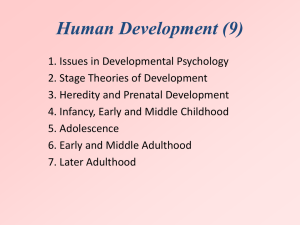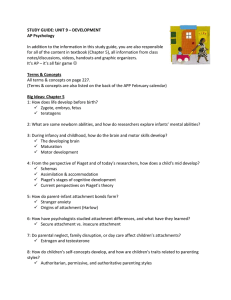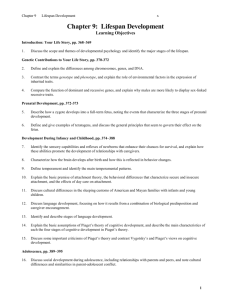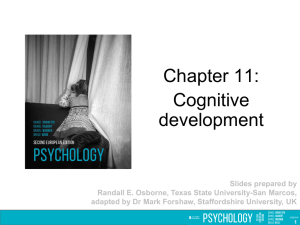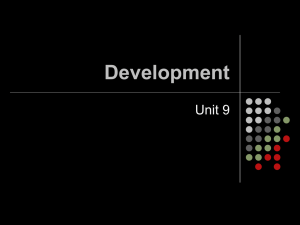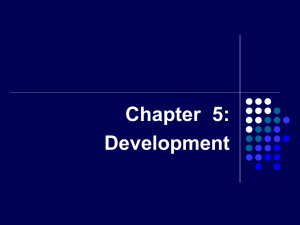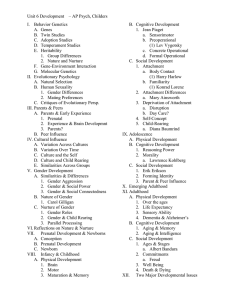AP Psych-Unit 9 PPT - Westinghouse College Prep
advertisement
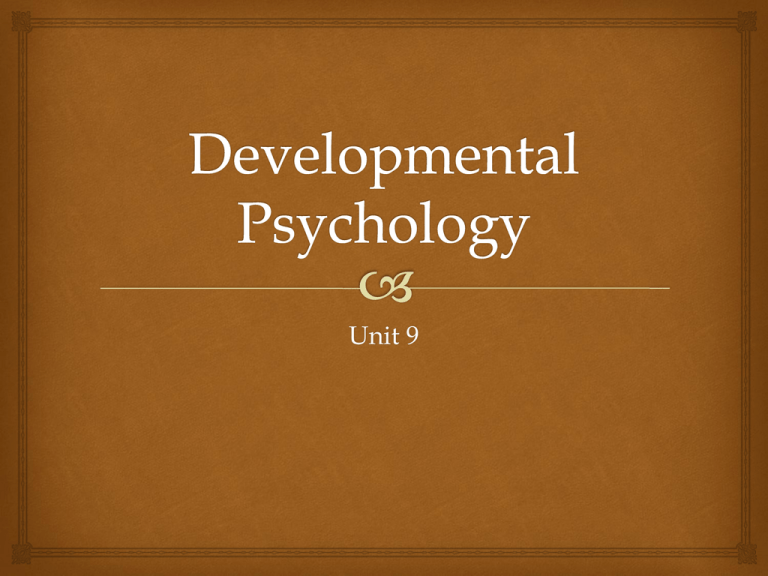
Unit 9 Prenatal Development and the Newborn Conception Only takes one sperm to penetrate the egg’s outer coating and fuse together to form a cell (baby) Zygote: conception to 2 weeks Embryo: 2 weeks to 8 weeks Fetus: 9 weeks to birth Prenatal development Cell division produces a zygote Fewer than half of all fertilized egss survive beyond the first 2 weeks After the zygote attaches to the mother’s uterine wall (embryo) Over the next 6 weeks organs began to form and function Prenatal development By 9 weeks looks “human” (fetus) Fetus becomes responsive to sound Mother’s voice over any others after birth Prenatal development Placenta-transfer nutrients and oxygen from mother to fetus and screens harmful substances Teratogens: harmful agents such as viruses and drugs No safe amount of alcohol during pregnancy Fetal alcohol syndrome: physical and cognitive abnormalities The newborn Born with coordinated sequence of reflexes Touches cheek>babies turn>open mouth> Reflexive tonguing, swallowing, sucking, and breathing Habituation: overtime decreasing responsiveness with repeated stimulation The Newborn We prefer familiar sights and sounds that facilitate social responsiveness We prefer objects 8 to 12 inches away (happens to be distance from nursing baby eyes to mothers eyes) Infancy and Childhood Physical Development On the day your were born you had the most brain cells you will ever have Neural networks grow more complex as you mature Maturation: growth enable changes in behavior uninfluenced by experience Infancy and Childhood Motor development Physical coordination Rolling over>crawling>walking (illustrating a maturing nervous system) Genes play a role Cerebellum (readiness to walk/balance) Infancy and Childhood Maturation and infant memory Infantile amnesia Average age of earliest conscious memory is 3.5 years Memory still processes information before that time Conscious mind not know or express in words, the nervous systems somehow remembers Sweating example of remembering pre-schoolers Cognitive Development Mental activities associate with thinking, knowing, remembering, and communicating Piaget’s studies proved that children minds develop in stages Piaget: “make sense of our experiences” Cognitive Development Maturing brain builds schemas, concepts or mental molds to our experiences First we assimilate new experiences (interpret) and later accommodate (adjust) our original schemas Spurts of change to greater cognitive stability Piaget’s theory and current thinking Sensorimotor stage From birth to 2 Take in the world through their sense and actionsthrough looking, hearing, touching, mouthing, and grasping Object permanence (young infants lack up until around 8 months) Piaget stages Preoperational Stage Until about age 6 or 7 Too young to perform mental operations Concept of conservation-that quantity remains the same despite changes in shape Egocentrism: difficulty perceiving things from another’s point of view Piaget theory of mind Begin to tease, empathize, and persuade Ability to take another’s perspective develops Children with autism have difficulty understanding other states of mind, reflecting on their own mental states, and less likely to use personal pronouns Gradually develop Concrete Operational Stage Around 6 or 7 till 12 Comprehend mathematical transformations and conversations Formal Operational Stage By age 12 Concrete reasoning to encompass abstract thinking Children begin to approach hypothetical propositions and deducing consequences Reflecting on Piaget’s Theory Identified significant cognitive milestones Studies around the globe have confirmed that human cognition unfolds as Piaget predicated Today researchers see development as more continuous that Piaget did Lev Vygotsky Emphasis on how the mind grows through interaction with the social environment Language provides the building blocks for thinking Zone of proximal development-what they could learn with and without help Interacting with others Implications for parents and teachers Positive feedback vs. negative feedback Better to build on what they already known engaging them in concrete demonstrations and stimulating them to think for themselves Children’s cognitive immaturity is adaptive Social Development Developing an intense bond with caregivers Stranger Anxiety- By 8 months some infants show a fear of STRANGERS Separation Anxiety- crying or otherwise showing distress if their mothers leave them (even if only for a few moments) Origins of Attachment Attachment-a powerful survival impulse that keeps infants close to their caregivers Infants become attached to those who satified their need for nourishment Origins of AttachmentBody contact Harlow experiment Monkey overwhelmingly preferred the comfy cloth mother as opposed to the wire mother who provided food Cling to mother (comfy) when anxious Rocking, warmth, and feed made the cloth mother even more appealing Origins of AttachmentFamiliarity Form during a critical period-an optimal period when certain events must take place to facilitate proper development Children become attached during a sensitive period Mere exposure to people and things fosters fondness Origins of Attachment Imprinting-certain animals attached during a critical time Goslings, dockings, chicks: hours after hatching Konrad Lorenz experiment Attachment differences: Temperament and Parenting Placed in a strange situation the majority of infants (60%) displayed secure attachment Play comfortably in their mothers presence, when she leaves they are distressed, and when se returns they seek contact Insecure attachment: cling to mom (won’t explore), upset or indifference toward mother leaving and returning (about how they react when parents return) Attachment differences Sensitive mothers and fathers tend to have securely attached infants One aspect of personality is temperament (reactive, intense, fidgety, easygoing, quiet, irritable, unpredictable, cheerful, relaxed) Heredity predisposes temperament differences Secure vs. Unsecure Secure: Mothers who are affectionate and RELIABLE >securely attached child *Secure children are happier, friendlier, and more cooperative. They are also less likely to MISBEHAVE and tend to do better in school Insecure: Unresponsive or unreliable caregiver >insecure child Attachment differences Erik Erikson: Securely attached children approach life with a sense of basic trusts (early parenting) Our early attachment forms the foundation for affection and intimacy later in life Affect future relationships with your own children Affect motivation Deprivation of Attachment Harlow monkey: cowered in fright or lashed out in aggression placed in rooms with other monkeys, incapable of mating Most children growing up under adversity are resilient and become normal adults However, others don’t bounce back so readily Extreme trauma leave footprints on the brain Slow serotonin response in abused children Disruption of Attachment Courts are reluctant to remove children from their homes If placed in a more positive and stable environment, most infants recover from separation distress A series of foster families can be very disruptive Deep and longstanding attachments seldom break quickly Does Daycare affect attachment? New research confirms quality day-care matters Socio-economic status readily determines quality of day-care Children ability to thrive under varied types of responsive caregivers Consistent/warm relationships, can form trusting relationships Child abuse and neglect Most parents are kind and LOVING Neglect: failure to give a child adequate food, shelter, emotional support, or schooling more problems result from neglect than from abuse *3 million children in the US are neglected Child abuse and neglect Stress, especially unemployment History of ABUSE Acceptance of violence as a way of coping Lack of ATTACHMENT to child Substance abuse Rigid attitudes about child REARING Children often imitate their parent’s behavior, but it is possible to break the CYCLE Self-concept By the end of childhood about age 12 most children have developed a self-concept-understanding of who they are Mirror images fascinate infants around 6 months About 18 months the child recognizes oneself in the mirror Self-concept By school age, children began to describe themselves in terms (gender, traits, comparison) By age 8 or 10, their self-image is quite stable Children who form positive self-concept are more confident, independent, optimistic, assertive, and sociable Parenting-style Authoritarian: parents impose rules and expect obedience Permissive: parents submit to their children’s desires Authoritative: both demanding and responsive Children with the highest self-esteem, self-reliance, and social comptence-____________ parents Culture and ChildRearing Western culture-independence Many Asian and African cultures value emotional closeness and encourage a strong sense of family sef All in all: children across place and time have thrived under various child-rearing systems Parents and Early Experiences Experience and brain development Enriched brains are more complex not necessarily bigger Rosenweig and Krech rat study Impoverished vs. enriched: activities, weight Exposer to language before adolescences Genie never mastered a language How much credit or (blame) do parents deserve? Countless genetic influences beyond their control Parents feel enormous satisfaction and guilt over their child’s successes or failures Freud blamed bad mothers Power of parenting-abusive, neglect, political attitudes, religious beliefs, manners Peer Influence We seek to fit in with groups and are subject to their influences Children will adopt the language accent of their peers not their parents Parents influenced the culture that shapes peer group (neighborhood, schools) Gender Development The biological and social characteristics by which people DEFINE as male or female Gender Similarities: among 46 chromosomes 45 are unisex More alike than different!!! Overall Gender Differences Age of puberty Women live 5 years longer, 70% carry more fat, 40% less muscle, 5 inches shorter, smell fainter odors, express emotions more freely, offered help more often, vulnerable to depression and anxiety, 10 times more likely to develop an eating disorder Men 4 times more likely to commit suicide or suffer alcohol dependence, far more diagnosed with autism, color-blindness, adhd, antisocial personality disorder Gender and Aggression Men tend to behave more aggressively Gender gap regarding physical aggression Throughout the world Hunting, fighting, (men receive more support to go to war) Gender and Social Power In most societies men are more socially dominant Leadership tends to go to males As leaders men are more autocratic, women tend to be more democratic Everyday behavior men are more likely to talking assertively, interrupting, initiating touches, staring more, and smiling less Such behaviors are sustain due to social power inequities: pay, political power Gender and Social Connectedness Surface early in children’s play Girls play in smaller groups, less competitive, more imitative, more open and responsive to feedback Boys play in large groups with an activity focus and little intimate discussion Gender and Social Connectedness Females are more interdependent: spend more time with friends, conversation Men-activities side by side and use conversation to communicate solutions Bonds are stronger between females Gender Differences Gender differences in power, connectedness, and other traits peak in late adolescence As teenage girls become less assertive and more flirtatious boys become more domineering and unexpressive By 50, men become more empathic and less domineering, women become more assertive and self-confident (especially if working) The nature of Gender Different sex chromosomes and differing concentrations of sex hormones Seven weeks determines sex: father decides the sex 4th-5th month sex hormones bathe the fetal brain and influence the wiring Women have thicker frontal lobes in the area involved in verbal fluency Part of the parietal cortex (space perception) is thicker than males Hippocampus, amygala differences The nature of Gender Hormonal malfunctions (will inject) Genetically female infants are born masculineappearing Hormones won’t reverse their gender identity Exhibit tomboyish behavior *The effect of early exposure to sex hormones is direct (appearance) and indirect influence of social experiments) The nurture of Gender Gender roles Our expectations about the way men and women SHOULD behave Can smooth social relations, saving awkward decisions, but if we deviate from conventions we may feel anxious Employed men spend less time at home (employed women spend more) Stayed home with sick child?__________, ________________countries offer the greatest gender equity. ___________and _________the least. The nurture of Gender Gender and Child-rearing Gender identity-sense of being male or female Gender typed-exhibit masculine or feminine traits Social learning theory: children learn gender-like behaviors by observing and imitating and by being rewarded or punished Cognition: gender schemas (shape experiences based on observation) Adolescence The years spend morphing from child to adult starts at the beginning of sexual maturity and ends with achievement of independent adult status G. Stanley Hall: A period of “storm and stress” Negative? Positive? Physical Development Puberty-mature sexually Beginning for girls around 11 and boys 13 Primary and secondary sex characteristics develop Timing: for boys early maturation: being stronger, athletic, >popular, self-assured, independent For girls early maturation: may suffer from teasing and sexual harrassment Physical Development As teens mature the frontal lobe continues to develop Bring improved judgment, impulse control, plan for long term However, hormonal surge and un-developed frontal lobe explains impulsive, risky teen behaviors Teens are guilty by reason of adolescence Juvenile death penalties unconstitutional Cognitive Development Developing reasoning power The ability to reason hypothetically and deduce consequences also enables them to detect inconsistencies in others’ reasoning and to spot hypocrisy Developing Morality Discerning right from wrong and developing character Kohlberg moral stages of development Preconvetional: before age 9 children morality on selfinterest Conventional: by early adolescence, focuses on caring for others and uphold laws and rules Postconventional: Actions judged as “right” because they flow from people's rights (or from self-defined) Moral Feeling Make moral judgments quickly Feel disgust when seeing people engaged in degrading acts or feel elated when seeing people to what is “right” Quick-gut feelings Humans are hard-wired for moral feelings Doing the right thing! Social Development Erik Erikson stages of psychosocial development Infancy (trust vs. mistrust) Adolescence (identity vs. role confusion) Forming an identity Group identities often form around how we differ from those around us Some forge their identity early, simply by adopting their parents’ values and expectations Other adolescents may adopt an identity define in opposition to parent but in conformity with a peer group Forming an identity Most young people do develop a sense of contentment with their lives A desire to accomplish something personally meaningful Identity becomes personalized Developing capacity for intimacy Parent and Peer Relationships Adolsecents begin to pull away from their parents to form their own identities Arguments between parents and kids are over mundane-things Parent-child conflict tends to be greater with first-borns Kids who are close to their parents tend to have close relationships with friends, healthy, and do good in school Teens look to parents regarding religious views and college/career over friends Emerging adulthood Delayed independence and earlier sexual maturity have widened the interlude between biological maturity and social independence 18-mid 20s: dependent on parents financially and emotionally Adulthood Physical Development Our physical abilities-muscular strength, reaction time, sensory keenness, and cardiac output all crest by the mid-twenties Physical changes in Middle Adulthood Physical vigor has less to do with age than with a person’s health and exercise Women-menopause Men-gradual decline in sperm count, tester one level, erection and ejaculation Physical changes in later life Increasing life expectancy combines with decreasing birthrates make older adults and larger population segment Women outlive women 5-6 years Body ages (with age people’s chromosome tips wear down and aging cells may die without being replaced with perfect genetic replicas) Why? Evolutionary theory Physical Changes Sensory abilities Visual sharpness diminishes Muscle strength, reaction time, and stamina Stairs get steeper, print gets smaller, people mumble more Physical Changes Health Body disease fighting immune system weakens, more susceptible to cancer and pneumonia not the common cold Slows the neural processing Memory and frontal lobe atrophy during aging Physical exercise stimulates brain cell development and neural connections Dementia and Alzheimer's Disease Substantial loss of brain cells A series of small stroke, a brain tumor, or alcohol dependence can progressively damage the brain causing dementia Alzheimer's First memory deteriorates then reasoning (& smell) After 5 to 20 years the person becomes emotionally flat, disoriented and disinherited, incontinent, and mentally vacant Cognitive Development Aging and memory The ability to recall new information decline during adulthood, but the ability to recognize new info did not Prospective memory (remember to): declines with age Teens/young adults are better at time-based tasks Easier to remember if information is meningful Cognitive Development: Intelligence Phase 1: Cross-sectional Evidence for Intellectual Decline In time tests fewer correct answer than younger adults Eventually challenged this idea Cognitive DevelopmentIntelligence Phase 2: Longitudinal Evidence for Intellectual Stability Intelligence remains stable until late in life Other environmental factors at play Never too old to learn Cognitive Development: Intelligence Phase 3: It all depends Multiple intelligences need to measure several distinct abilities Those who are around may be bright healthy people Crystallized intelligence-accumulated knowledge increases up to old age Fluid intelligence-ability to reason speedily and abstractly decreases slowly up to age 75 Mental ability strongly correlates with proximity to death Social Development: Ages and Stages Forties-middle adulthood Crisis? Not really-unhappiness, divorce, job dissatisfaction does not rise Divorce most common in 20s, Suicide most common 70-80s Social clock-”right time” Western world-still ticks but people feel freer to be out of sync with it Chance events-romantic partner Repeated exposure, similar background, class, attractiveness, reciprocates your affections Social Development: Adulthood Commitments Love Adult bonds of love are most satisfying marked by similarity of interests and values, sharing of emotional and material support, intimate self-disclosure Stronger with couple who marry after 20 Why is the divorce rate high? Women’s lessened economic dependence on men, and rising expectations Enduring bond, equal wage earner, caregiver, intimate friend, warm, responsive lover Social Development: Adulthood Commitments Those who cohabit before marriage have had higher rates of divorce Less committed to the ideal of enduring marriage Less marriage-supporting while cohabiting Marriage is a predictor of happiness, health, sexual satisfaction, and income Marriage that last are not always devoid of conflict Five-to-one ratio of positive to negative interactions Smiling, touching, complimenting, and laughing as opposed to criticism, sarcasm, insults Social Development: Adulthood Commitments Work Difficult Not directly tied to your college majors Happiness is key: do what makes you happy Social Development: Adulthood Commitments When children begin to absorb time, money, and emotional energy, & satisfaction Empty nester syndrome: sometimes can be difficult or launch a second honeymoon Well-being across the life span From teens to midlife, people experience a strengthening sense of identity, later in life challenges arise Happiness is higher in older adults Risk of depression tapers off in later life Bad feelings we associate with negative events fade faster than do the good feeling we associate with positive events Well-being across the life span As we age (later in life) we find ourselves less often feeling excited and provoke less elation and criticism Less intense joy but more contentment and increased spirituality (especially if social) Death and Dying Most difficult separation is from a spouse (women suffer) Grief is severe when the death of a loved one is unexpected and before the “social clock” Facing death with openness helps people make sense of life’s meaningfulness and unity (sense of integrity) Reflections on three major developmental Issues Nature vs. nurture both impact development Continuity and Stages Researchers emphasize experience see development as slow continuous process Researchers emphasize biology see development as predisposed stages Research cast doubt on the idea that life proceeds through neatly defined, age-linked stages, the stage concept remains useful Reflections on development Stability and Change Personality gradually stabilizes with age Life requires both Stability to depend on others Change motives our concerns about present influences
